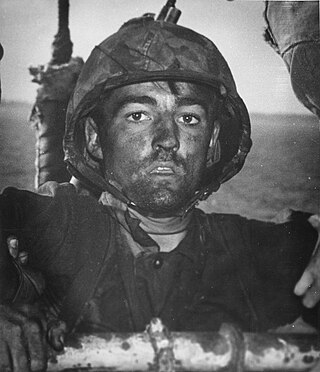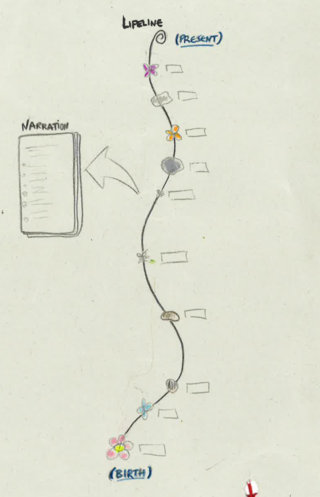
"Truth serum" is a colloquial name for any of a range of psychoactive drugs used in an effort to obtain information from subjects who are unable or unwilling to provide it otherwise. These include ethanol, scopolamine, 3-quinuclidinyl benzilate, midazolam, flunitrazepam, sodium thiopental, and amobarbital, among others.
Neurosis is a term mainly used today by followers of Freudian thinking to describe mental disorders caused by past anxiety, often that has been repressed. In recent history, the term has been used to refer to anxiety-related conditions more generally.
Post-traumatic stress disorder (PTSD) is a mental and behavioral disorder that develops from experiencing a traumatic event, such as sexual assault, warfare, traffic collisions, child abuse, domestic violence, or other threats on a person's life or well-being. Symptoms may include disturbing thoughts, feelings, or dreams related to the events, mental or physical distress to trauma-related cues, attempts to avoid trauma-related cues, alterations in the way a person thinks and feels, and an increase in the fight-or-flight response. These symptoms last for more than a month after the event and can include triggers such as misophonia. Young children are less likely to show distress, but instead may express their memories through play. A person with PTSD is at a higher risk of suicide and intentional self-harm.
In psychology, false memory syndrome (FMS) was a proposed "pattern of beliefs and behaviors" in which a person's identity and relationships are affected by false memories of psychological trauma, recollections which are strongly believed by the individual, but contested by the accused. False memory syndrome was proposed to be the result of recovered memory therapy, a scientifically discredited form of therapy intended to recover memories. Originally conceptualized by the False Memory Syndrome Foundation, the organization sought to understand what they understood as a general pattern of behaviors that followed after a patient underwent recovered memory therapy and to come up with a term to explain the pattern. The principle that individuals can hold false memories and the role that outside influence can play in their formation is widely accepted by scientists, but there is debate over whether this effect can lead to the kinds of detailed memories of repeated sexual abuse and significant personality changes typical of cases that FMS has historically been applied to. FMS is not listed as a psychiatric illness in any medical manuals including the ICD-11, or the DSM-5. The most influential figure in the genesis of the theory is psychologist Elizabeth Loftus.
Dissociation is a concept that has been developed over time and which concerns a wide array of experiences, ranging from a mild emotional detachment from the immediate surroundings, to a more severe disconnection from physical and emotional experiences. The major characteristic of all dissociative phenomena involves a detachment from reality, rather than a false perception of reality as in psychosis.
Psychological trauma is an emotional response caused by severe distressing events that are outside the normal range of human experiences. It must be understood by the affected person as directly threatening the affected person or their loved ones generally with death, severe bodily injury, or sexual violence; indirect exposure, such as from watching television news, may be extremely distressing and can produce an involuntary and possibly overwhelming physiological stress response, but does not produce trauma per se. Examples of distressing events include violence, rape, or a terrorist attack.

Combat stress reaction (CSR) is acute behavioral disorganization as a direct result of the trauma of war. Also known as "combat fatigue", "battle fatigue", or "battle neurosis", it has some overlap with the diagnosis of acute stress reaction used in civilian psychiatry. It is historically linked to shell shock and can sometimes precurse post-traumatic stress disorder.

Amobarbital is a drug that is a barbiturate derivative. It has sedative-hypnotic properties. It is a white crystalline powder with no odor and a slightly bitter taste. It was first synthesized in Germany in 1923. It is considered a short to intermediate acting barbiturate.
Dissociative disorders (DDs) are a range of conditions characterized by significant disruptions or fragmentation "in the normal integration of consciousness, memory, identity, emotion, perception, body representation, motor control, and behavior." Dissociative disorders involve involuntary dissociation as an unconscious defense mechanism, wherein the individual with a dissociative disorder experiences separation in these areas as a means to protect against traumatic stress. Some dissociative disorders are caused by major psychological trauma, though the onset of depersonalization-derealization disorder may be preceded by less severe stress, by the influence of psychoactive substances, or occur without any discernible trigger.

Complex post-traumatic stress disorder is a stress-related mental disorder generally occurring in response to complex traumas, i.e., commonly prolonged or repetitive exposures to a series of traumatic events, within which individuals perceive little or no chance to escape.
Exposure therapy is a technique in behavior therapy to treat anxiety disorders. Exposure therapy involves exposing the patient to the anxiety source or its context. Doing so is thought to help them overcome their anxiety or distress. Numerous studies have demonstrated its effectiveness in the treatment of disorders such as generalized anxiety disorder (GAD), social anxiety disorder (SAD), obsessive-compulsive disorder (OCD), post-traumatic stress disorder (PTSD), and specific phobias.
Childhood trauma is often described as serious adverse childhood experiences (ACEs). Children may go through a range of experiences that classify as psychological trauma; these might include neglect, abandonment, sexual abuse, emotional abuse, and physical abuse, witnessing abuse of a sibling or parent, or having a mentally ill parent. These events have profound psychological, physiological, and sociological impacts and can have negative, lasting effects on health and well-being such as unsocial behaviors, attention deficit hyperactivity disorder (ADHD), and sleep disturbances. Similarly, children whose mothers have experienced traumatic or stressful events during pregnancy have an increased risk of mental health disorders and other neurodevelopmental disorders.
Prolonged exposure therapy (PE) is a form of behavior therapy and cognitive behavioral therapy designed to treat post-traumatic stress disorder. It is characterized by two main treatment procedures – imaginal and in vivo exposures. Imaginal exposure is repeated 'on-purpose' retelling of the trauma memory. In vivo exposure is gradually confronting situations, places, and things that are reminders of the trauma or feel dangerous. Additional procedures include processing of the trauma memory and breathing retraining.

Barbiturates are a class of depressant drugs that are chemically derived from barbituric acid. They are effective when used medically as anxiolytics, hypnotics, and anticonvulsants, but have physical and psychological addiction potential as well as overdose potential among other possible adverse effects. They have been used recreationally for their anti-anxiety and sedative effects, and are thus controlled in most countries due to the risks associated with such use.

William Jefferson Bleckwenn was an American neurologist, psychiatrist, and military physician, who was instrumental in developing the treatment known as "narcoanalysis" or "narcosynthesis", also known by the lay term "truth serum".
PTSD or post-traumatic stress disorder, is a psychiatric disorder characterised by intrusive thoughts and memories, dreams or flashbacks of the event; avoidance of people, places and activities that remind the individual of the event; ongoing negative beliefs about oneself or the world, mood changes and persistent feelings of anger, guilt or fear; alterations in arousal such as increased irritability, angry outbursts, being hypervigilant, or having difficulty with concentration and sleep.

Richard Allan Bryant is an Australian medical scientist. He is Scientia Professor of Psychology at the University of New South Wales (UNSW) and director of the UNSW Traumatic Stress Clinic, based at UNSW and Westmead Institute for Medical Research. His main areas of research are posttraumatic stress disorder (PTSD) and prolonged grief disorder. On 13 June 2016 he was appointed a Companion of the Order of Australia (AC), for eminent service to medical research in the field of psychotraumatology, as a psychologist and author, to the study of Indigenous mental health, as an advisor to a range of government and international organisations, and to professional societies.

Hypnoanalysis is the technique of using hypnosis in the practice of psychoanalysis and psychotherapy. It attempts to utilize the trance state induced by hypnosis to effect a conscious understanding of a person's unconscious psychodynamics.

WWII lasted from September 1st, 1939 until September 2nd, 1945. The death toll during WWII has been estimated to be between 35,000,000 and 60,000,000. However, the exact number is unknown. With all those fatalities, it should not be surprising that it left so many lasting effects on the survivors. There have been many terms for these lasting effects over the decades. These terms include, but are not limited to, shell shock and combat fatigue. In 1980, the diagnosis of PTSD was added to the newly published DSM 3.

Narrative Exposure Therapy (NET) is a short-term psychotherapy used for the treatment of post-traumatic stress disorder and other trauma-related mental disorders. It creates a written account of the traumatic experiences of a patient or group of patients, with the aim of recapturing self-respect and acknowledging the patient's value. NET is an individual treatment, NETfacts is a format for communities. Narrative Exposure Therapy is a subtype of Written Exposure Therapy.









